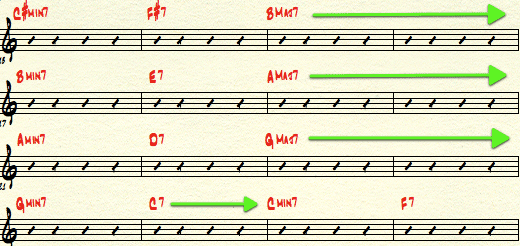How do I connect chords when I’m soloing? You’re asking yourself this question in the practice room and you’re frustrated when there doesn’t seem to be an easy answer. But you’re not alone. This is a question that every improviser struggles with as they create solos over tunes. Improvising over one chord is simple enough, however when you begin to play tunes with actual chord progressions, creating and connecting lines becomes a bit more challenging.
This musical obstacle goes to the heart of the skills you need as an improviser and the solution, like many obstacles we encounter in music, is simple in theory yet significantly more involved in implementation.
Imagine for a moment that you took away all the theory terminology, the voice leading rules, the maze of scales and the chord symbol jargon that you normally encounter as an improviser. What would you be left with? You’d be left with sound – that’s it!
Despite everything that our brains get caught up in as we try to create a solo, the harmonic aspect of improvisation boils down to sound: Individual sounds (chords) and the relationships between these sounds.
As an improviser a theoretical understanding and technical proficiency are the first steps when approaching these harmonic relationships, but your ultimate goal is melody. Can you create a seamless melody over these sounds and subsequent chord progressions?
Your ability to play melodies over a chord progression is directly related to how well you can hear the individual chords of a progression and the relationships between them. If you want to play effortlessly over any chord progression you need to start by focusing intently on the movement between one chord and the next.
Approaching chord relationships
Think back to the first time that you where introduced to the idea of a chord progression. If you were like a lot of people most of your time was spent figuring out “stuff” to play over those individual chords, not on the relationship or melodic connection of the entire progression.
Around the same time you also likely encountered the ii-V7-I progression. With this harmonic relationship came ideas of connection like voice leading, guide tone lines, and 7-3 resolutions. This is a great place to start learning the basics of functional harmony and chord relationships.
Many musicians begin their journey into chord progressions with a study of ii-V’s, the only problem is that this is also where their study of harmonic relationships stops. If you think about it a ii-V-I only contains two chord relationships: a minor ii chord moving to the dominant V7 chord and a V7 chord resolving to the I chord.
However, take a quick listen to any tune and you’ll immediately see that you’re going to need to know more than just these two chord relationships.
While the progression of a sub-dominant to a dominant to the tonic is a progression that is central to much of Western music, there are definitely other key chord relationships that you should know to be fully prepared to play any standard.
Below are six common chord relationships, besides the standard ii-V-I progression, that you should start incorporating into your daily practice routine:
Parallel Minor
The direct movement from a major chord to its parallel minor is surprisingly common within the body of standards that are frequently played by musicians. There is something inherently logical about stating a melody in major and then moving it to minor. For instance take a listen to the opening four bars of Ornithology:
As an improviser this is an important relationship to have in your ear and under your fingers. Being able to modulate quickly from a major sound directly its parallel minor will serve you well in many situations. Here are a few other standards that utilize a direct modulation from major to minor:
- Just Friends
- On Green Dolphin St.
- How High the Moon
- I’ll Remember April
This parallel minor relationship also appears in some not so obvious places as well. Take a look at the bridge to Cherokee:
We often think of the bridge to Cherokee as four separate ii-V’s that descend in whole steps (play a ii-V in B – stop! – play a ii-V in A – stop!…etc.) Instead aim to create a seamless line where the resolution of one ii-V connects to beginning of the next ii-V a whole step lower. This means utilizing and mastering the above parallel minor relationship – B Major to B minor, A Major to A minor, G Major to G minor.
II7 to ii-7
The parallel minor relationship doesn’t have to be limited to only the movement from Major 7 to minor 7 chords, you also frequently find this chord relationship between Dominant 7 and minor 7 chords. For instance, take the last 8 bars of the A section of Cherokee:
Or the opening chords to If I Were a Bell:
In both cases the Dominant II chord modulates to ii-7 resulting in the progression: II7 – ii-7 – V7 – I. Other tunes utilizing this relationship:
- Take the A Train
- Just Friends
- Donna Lee
I7 to IV7 (movement by 4ths)
The progression from the I chord to the IV chord is so common that it is often overlooked, but this is an essential progression to have at your disposal. Here are two standard examples of I to IV7:
Blues (dominant I chord moving to a dominant IV chord):
Rhythm Changes (bridge in the key of C):
The movement of a I7 chord to a IV7 chord is essentially a V7 to I relationship. When you begin to think of this harmonic relationship in this way the progression becomes much more logical and intuitive. You aren’t just switching between random dominant chords, there is a V to I resolution implied.
In the above examples you can also imply a ii-V7 progression over the I7 chord (see this article for more on implied progressions). For example on the first 4 bars on the bridge to Rhythm Changes:
And if you turn every V7 chord on the bridge you’ll encounter the parallel minor relationship from above:
This fourth relationship can also be found in other standards between two minor chords or two major chords. For example check out the opening 8 bars of All the Things You Are:
I to VI7 (Sixth relationship)
To be able to improvise well over most standards you need to have the relationship of a I chord to the VI chord down. Not only a mental grasp of this movement, but a repertoire of language for this harmonic relationship in all 12 keys. The most prevalent example of this sixth relationship is the A section to Rhythm Changes.
The first few measures of Donna Lee is another good example:
I – #i°
A chord that provides the same function as the VI7 chord is a #i° chord. Instead of the chord sequence I – VI – ii – V you can also play have I – #i°7 – ii – V7, essentially implying a VI7 flat9 and utilizing a half-step root movement. Some tunes that use this chord relationship are:
- Easy Living
- Have You Met Miss Jones
Half-Steps (I to bII)
The relationship of a half step is also common among the standards you’ll encounter as an improviser. Take a listen to the first four bars of You Stepped Out of a Dream:
A descending half-step progression can also be found in Donna Lee:
A few other examples of standards that utilize half-step harmonic relationships:
- So What
- Well You Needn’t
Minor Third Relationships
Another chord relationship to get in your ears and under you fingers is a minor 3rd relationship. The most well known example of this chord relationship is John Coltrane’s tune Giant Steps:
Quickly changing key centers like the ones found in the progression to Giant Steps take some serious practice. Learning this sequence of chord relationships is also useful in reharmonizing standards or implying chord substitutions:
Tonic to Half-Diminished vii (I – viiø)
One other progression that is also very common is the movement from the I chord to the viiø chord. You’ll find this progression in:
- Bird Blues (Blues for Alice)
- Confirmation
- Come Rain or Come Shine:
Practicing these chord relationships
So now that we’ve identified these six chord relationships, how are you going to practice them?
Well, before you can get to work on any chord progression, you have to start by learning the sound of the individual chords. The logic is simple, if you can’t play over one chord, how are you going to connect multiple chords?
For example if you want to improvise effectively over the parallel minor relationship, you need to begin by understanding (aurally and mentally) each individual chord in that chord progression. This means developing technique, doing a few ear training exercises and learning language for both a Major chord and a minor chord.
Then once you have those sounds in your ear and under your fingers, you need to get some language for each of these chords. Think of these two steps as prerequisites before you can start connecting chords. If you’re wondering where to start check out some of these articles for information about hearing the basic chords and gathering language:
- How to acquire useful language
- The difference between jazz licks and jazz language
- Fundamental ear training: seventh chords
- Practicing all four directions
- How to practice scales for speed
This process is the same for any other chord progression, and the 6 harmonic relationships listed above are no exception. Once you have acquired some language and can hear these individual sounds, it’s time to focus on the relationship between these two sounds. Below are four steps for learning any chord relationship that you come across.
Step 1: Isolate the chord relationship
The first step in learning any of the above chord relationships is to isolate the two chords in question. As an example let’s take the parallel minor relationship from above:
Start by going to the piano and slowly playing the two chords over and over again. (Not sure about how to voice a chord on piano? See this article.) The goal is to get the sound of this harmonic relationship in your ear. Hear the movement between the roots, thirds, fifths, sevenths, and upper structures of the chords as the harmony shifts. Listen for any common tones or half-step resolutions between the two chords.
Next find a recording of a tune that contains this progression (ex. the first 4 bars of Ornithology). Isolate that spot in Transcribe! and loop it. Again listen to the movement from one chord to the next.
Step 2: Transcribe language
Once you understand this chord relationship and have the harmonic movement in your ears it doesn’t automatically guarantee that you’ll be playing great lines over this chord progression. You need to start by learning and studying a musical model.
The way you learn the jazz language is by transcribing the lines and solos of great players. When you’re working on a specific harmonic relationship, find a specific line that you like over this spot in the progression, then slow it down and learn that line.
To continue with the example of the parallel minor chord relationship, you might want to check out how Clifford Brown or Sonny Rollins improvise over the parallel minor change in I’ll Remember April.
Find a line that grabs your ear, slow it down, sing it and learn it on your instrument. Once you have it down the next step is to learn this piece of language in all 12 keys. This is one piece of language that you have when you encounter a parallel minor relationship.
Step 3: Repetition and variation
Now that you have a piece of language to work with, you need to make this line your own. The final goal of transcribing solos is not to cut and paste these lines directly into your own solos, it’s to ingrain all of these lines and have them evolve over time into your own language.
After you’ve learned and internalized a piece of language from the record it’s time to personalize this line by altering it (harmonically, rhythmically, and melodically) and combining it with other language that you’ve already developed.
Check out these posts for some ideas on varying your transcribed language:
- Quadruple your jazz language
- How to apply the jazz language you’ve transcribed
- How to phrase like a pro
- Using Permutation to create unlimited musical ideas
- Exploring space
After you have some variations on the original line, take these new lines through every key.
Step 4: Create your own lines
Finally we’re back where we started – creating improvised lines that connect a chord progression. Only this time, instead of shooting unsuccessfully in the dark, we’ve gone through the steps of learning language and creating our own. You see, contrary to what a lot of people think about improvisation, you can’t create lines out of thin air. Improvising is a skill developed from hours of practice not a talent that you either have or don’t have.
When you’ve haven’t practiced these chord relationships and have no language to play of course it’s going to feel impossible – this is just a sign that you haven’t developed these skills yet. Whether you’re working on hearing chord progressions, trying to improve your technique, or striving to connect various chord relationships the answer is not going to come to you without any work.
By incorporating these six harmonic relationships into your practice routine, in addition to your usual ii-V-I practice, you’ll find yourself much more prepared to solo over the tunes in the standard repertoire.




























